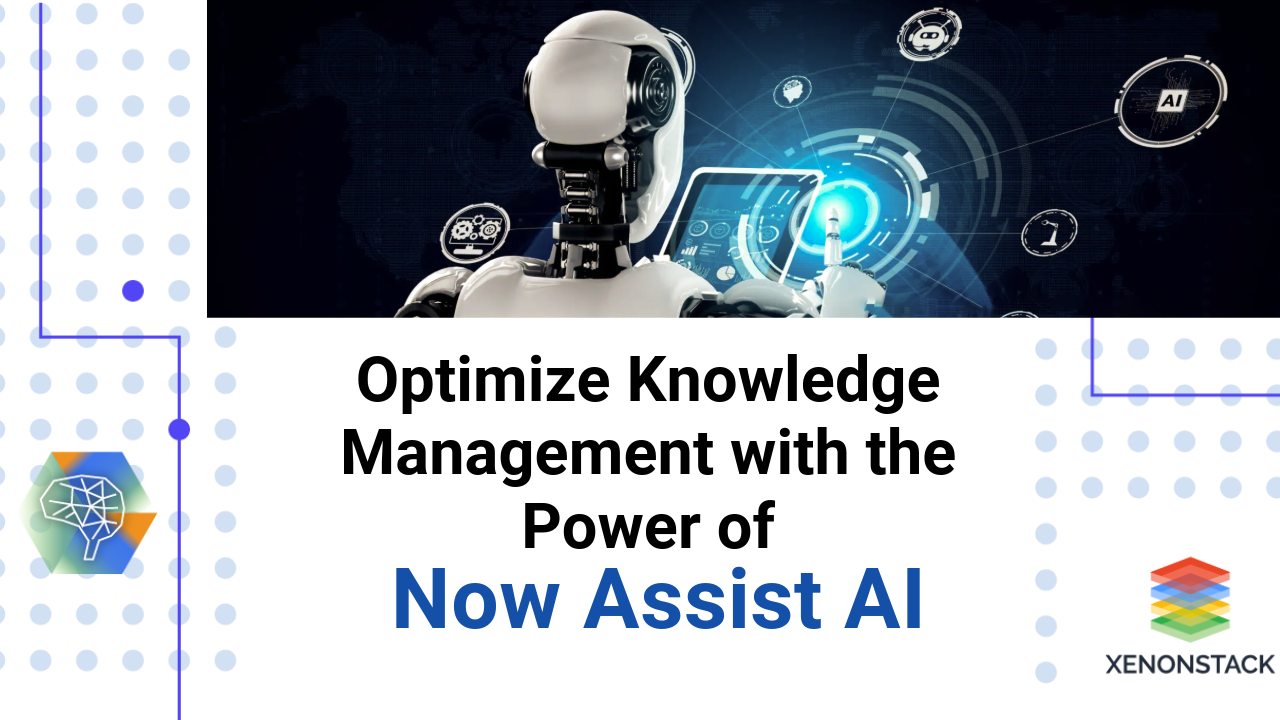
Introduction to the ServiceNow AI Platform
In today's cybersecurity landscape, Security Operations Centers (SOCs) need to rapidly detect and respond to threats. Integrating autonomous agents like ServiceNow's Now Assist can significantly improve these operations. This blog explores how Now Assist can be configured to create an autonomous agent that enhances security operations.
Overview of Now Assist
Now Assist is an intelligent platform that enhances user experiences through automation and machine learning. It streamlines operations, improves decision-making, and boosts productivity. For security operations, Now Assist automates routine tasks, offers advanced analytics, and ensures seamless incident management.
Key Features and Components of ServiceNow AI Agents
1. Intelligent Automation
Now Assist automates repetitive tasks using machine learning algorithms, reducing the workload on security analysts.
Task Automation: Now Assist can handle a variety of routine tasks that traditionally require manual intervention. For example, it can automatically categorize security incidents based on predefined criteria such as severity, type, and source. This categorization helps prioritize incidents, ensuring that the most critical issues are addressed first.
Incident Prioritization: The platform uses machine learning to prioritize incidents by assessing their potential impact on the organization. By analyzing historical data and current threat intelligence, Now Assist can determine which incidents pose the greatest risk and need immediate attention.
Automated Responses: Once incidents are categorized and prioritized, Now Assist can generate automated responses. These responses might include sending notifications to relevant stakeholders, isolating affected systems, or initiating predefined remediation actions. Automating these responses not only speeds up incident resolution but also reduces the chances of human error.
2. Advanced Analytics
The platform's analytics capabilities enable real-time monitoring and analysis of security data.
Real-Time Monitoring: Now Assist continuously monitors network traffic, system logs, and other data sources to detect unusual activity that may indicate a security threat. This real-time monitoring is crucial for identifying and responding to threats as they occur.
Data Analysis: The platform employs advanced data analysis techniques to identify patterns and anomalies in the data. For example, it can detect unusual login attempts, abnormal data transfers, or unexpected changes in system configurations. By identifying these anomalies, Now Assist helps security teams uncover potential threats that might otherwise go unnoticed.
Threat Detection:Now, Assist analytics capabilities enable proactive threat detection. Instead of waiting for a security incident to occur, the platform can identify potential threats based on historical data and current trends. This proactive approach allows organizations to address vulnerabilities before attackers can exploit them.
3. Seamless Integration
Now Assist integrates with various security tools and platforms, providing a unified view of the security landscape.
Integration with SIEM: Now Assist can be integrated with Security Information and Event Management (SIEM) systems. SIEM integration allows the platform to collect and analyze data from multiple sources, including firewalls, intrusion detection systems, and antivirus software. This comprehensive data collection provides a holistic view of the organization's security posture.
Endpoint Protection Integration: By integrating with endpoint protection platforms, Now Assist can monitor and manage security incidents on individual devices. This integration ensures that threats are detected and mitigated at the endpoint level, preventing them from spreading across the network.
Unified Dashboard: Now Assist consolidates data from various security tools into a single, unified dashboard. This unified view makes it easier for security analysts to monitor the organization's overall security status and quickly respond to incidents. The dashboard provides real-time insights into security events, incident status, and overall security posture.
Configuring ServiceNow Autonomous Agents for Security Operations
Setting up Now Assist involves several steps:
Initial Setup and Customization
1. Platform Deployment: Deploy Now Assist on your preferred infrastructure, either on-premises or in the cloud.
2. User and Role Management: Define user roles and permissions to ensure that only authorized personnel have access to critical security operations features.
3. Workflow Configuration: Customize workflows to align with your security operations processes. This includes setting up incident response workflows and configuring alert rules.
Training Machine Learning Models
Training Now Assist's machine learning models involve:
1. Data Collection: Gather historical security incident data to train the machine learning models.
2. Model Training: Train models using Now Assist’s built-in capabilities, involving feature extraction, model selection, and parameter tuning.
3. Model Validation: Validate the trained models to ensure accuracy and reliability by testing them on a separate validation dataset.
Integration with Existing Security Tools
1. SIEM Integration: Integrate Now Assist with your Security Information and Event Management (SIEM) system to pull security event data for incident detection and response.
2. Endpoint Protection Integration: Connect Now Assist to endpoint protection platforms to monitor and manage endpoint security incidents.
3. Threat Intelligence Feeds: Integrate threat intelligence feeds to enrich incident detection with real-time threat data.
Continuous Monitoring and Optimization
1. Performance Monitoring: Continuously monitor Now Assist’s performance using built-in analytics tools to track key performance indicators (KPIs) such as incident response time and automation effectiveness.
2. Regular Updates: Keep Now Assist and its machine learning models updated with the latest data and threat intelligence.
3. Feedback Loop: Establish a feedback loop with security analysts to gather insights and improve the platform's capabilities.
Advanced Use Cases for ServiceNow AI Agents
Automated Incident Response
Now Assist can automate the incident response lifecycle, from detection to remediation. For example, upon detecting a phishing attempt, Now Assist can:
1. Isolate Affected Systems: Use endpoint protection tools to isolate compromised systems.
2. Notify Stakeholders: Send automated notifications to relevant stakeholders.
3. Remediate the Threat: Execute remediation scripts to remove the threat and restore systems.
4. Generate Reports: Create detailed incident reports documenting the attack and response actions.
Proactive Threat Hunting
Now Assist’s analytics capabilities can be used for proactive threat hunting. Security analysts can:
1. Identify Anomalies: Analyze network traffic and logs to spot anomalies.
2. Investigate IOCs: Use threat intelligence to investigate indicators of compromise (IOCs).
3. Automate Mitigation Actions: Execute predefined response actions to mitigate identified threats.
Security Posture Assessment
Now Assist can assess an organization's security posture by:
1. Vulnerability Scanning: Integrate with scanning tools to identify and prioritize vulnerabilities.
2. Compliance Monitoring: Monitor compliance with security policies and regulations.
3. Risk Assessment: Perform automated risk assessments to provide insights for improving security posture.
Impact of Leveraging ServiceNow Autonomous Agents
The implementation of Now Assist in security operations can have a profound impact on the overall efficiency and effectiveness of an organization’s SOC. Here are some key impacts:
Enhanced Efficiency
-
Time Savings: By automating routine tasks such as incident categorization and prioritization, Now Assist significantly reduces the time security analysts spend on these activities. This allows them to focus on more critical and complex tasks.
-
Reduced Human Error: Automating repetitive tasks minimizes the risk of human error, which can often lead to oversight in threat detection and response. Now, Assist ensures that each task is performed consistently and accurately.
Improved Threat Detection and Response
-
Faster Incident Response: With real-time monitoring and automated responses, Now Assist ensures that incidents are detected and addressed promptly. This rapid response capability is crucial in mitigating the impact of security breaches.
-
Proactive Threat Management: Advanced analytics enable Now Assist to identify potential threats before they materialize into actual incidents. This proactive approach helps organizations stay ahead of attackers and prevent breaches.
Better Resource Allocation
-
Optimized Analyst Workload: By taking over routine tasks, Now Assist allows security analysts to dedicate their time and expertise to more strategic initiatives such as threat hunting and incident investigation.

implementing ServiceNow AI Platform: A Step-by-Step Guide
Step 1: Initial Setup
Deploying Now Assist involves setting up the platform on your preferred infrastructure. Whether on-premises or cloud-based, ensure the environment is secure and meets all necessary requirements. Define roles and permissions to control access to critical features and data.
Step 2: Customizing Workflows
Customization is key to aligning Now Assist with your organization's security operations. Define incident response workflows, including escalation paths and notification rules. Customize the user interface to display relevant security metrics and dashboards.
Step 3: Integrating with Existing Systems
Integrate Now Assist with existing security tools such as SIEM systems, endpoint protection platforms, and threat intelligence feeds. This integration allows Now Assist to pull in data from various sources, providing a comprehensive view of the security landscape.
Step 4: Training and Validating Machine Learning Models
Gather historical data on security incidents to train Now Assist’s machine learning models. This involves feature extraction, model training, and validation. Use a separate validation dataset to test the models and ensure their accuracy and reliability.
Step 5: Continuous Monitoring and Optimization
Monitor Now Assist's performance using built-in analytics tools. Track key performance indicators such as incident response time and automation effectiveness. Update the machine learning models regularly with new data and refine workflows based on feedback from security analysts.
Establishing Clear Objectives with ServiceNow Autonomous Agents
Establish Clear Objectives
Define clear objectives for what you want to achieve with Now Assist. This could include reducing incident response times, improving threat detection accuracy, or automating routine tasks to free up analysts for more complex work.
Engage Stakeholders
Involve key stakeholders from the beginning to ensure that the implementation of Now Assist meets the needs of all relevant parties. Regular communication and feedback loops are essential for the successful adoption of the platform.
Regular Training and Updates
Ensure that all users are adequately trained on how to use Now Assist effectively. Provide ongoing training sessions to keep everyone up-to-date with the latest features and best practices. Regularly update the platform to incorporate new capabilities and improvements.
Conclusion: Maximizing the Benefits of ServiceNow AI Solutions
ServiceNow's Now Assist offers powerful tools for enhancing security operations through automation and analytics. Configuring Now Assist as an autonomous agent can significantly improve SOC efficiency and effectiveness. Embracing this technology is a crucial step toward building a resilient security posture in today's digital landscape.
By leveraging Now Assist, organizations can ensure efficient, agile, and precise responses to evolving security threats.
Explore more



